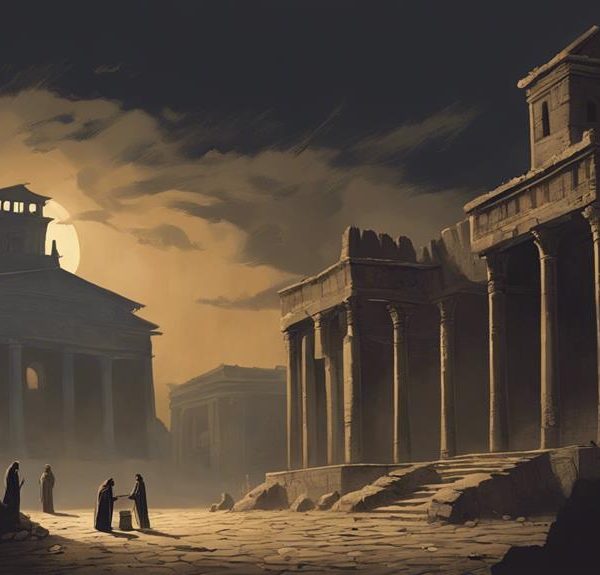Immerse yourself in the exploration of 'Pinnacle' in the Bible, where architecture and spirituality converge to reveal profound truths.

Pinnacle Meaning in the Bible
Imagine you're exploring the ancient streets of Jerusalem and you come across the very pinnacle of the temple mentioned in the Bible during the temptation of Jesus. This isn't just a high point in architecture; it's a symbol loaded with meaning, from tests of faith to prophetic insights.
As you stand there, you realize there's a depth to the term 'pinnacle' that goes beyond its literal sense, hinting at spiritual heights and moral challenges. Now, consider how this concept has evolved over centuries and what it could mean for your own journey.
Isn't it intriguing to think about what revelations await as you explore further into its symbolism and application throughout biblical history and into modern interpretations?
Key Takeaways
- The pinnacle symbolizes the highest spiritual aspirations and connection between Heaven and Earth.
- It represents both the challenges and temptations encountered on the spiritual journey.
- Pinnacles in biblical narratives often denote moments of divine intervention and fulfillment of God's promises.
- Modern interpretations view the pinnacle as a metaphor for ongoing spiritual growth and moral discernment.
Historical Context of 'Pinnacle

To fully appreciate the significance of 'pinnacle' in biblical texts, it's essential to delve into its historical context, exploring how this term shaped and was shaped by the cultural and architectural realities of the times. The concept of a pinnacle, often associated with the highest point of a structure, carries deep architectural design implications. In ancient times, constructing a building's pinnacle required not only architectural ingenuity but also conveyed a structure's cultural significance. The pinnacle wasn't just a physical high point; it symbolized a reaching towards the divine, an aspiration to bridge the gap between the earthly and the heavenly.
As you examine the architectural landscapes of biblical times, you'll find that pinnacles served as markers of spiritual and societal aspirations. They weren't merely decorative; they were imbued with profound religious meaning. This architectural element underscored a community's values, its reverence for the divine, and its quest for connection with something greater than itself. Understanding the historical and cultural backdrop of the pinnacle enriches your appreciation of its mention in biblical texts, revealing layers of meaning that resonate with the architectural and spiritual ambitions of ancient societies.
The Temptation of Jesus

In examining the Temptation of Jesus, we uncover a pivotal moment that highlights the spiritual and moral tests faced by Christ during his earthly ministry. The desert solitude becomes not merely a backdrop but a significant stage for this profound event. Here, amidst the austere landscape, Jesus fasts for forty days and nights, a period laden with symbolic meaning. This fasting signifies not only physical abstinence but also a deep, spiritual preparation, aligning His will with that of the Father, showcasing the significance of fasting in spiritual fortitude and discernment.
As you delve deeper into this narrative, you'll recognize the desert's dual role as both a place of isolation and a crucible for spiritual strength. It's in this seeming emptiness that Jesus' resolve is tested by the tempter. Yet, it's precisely here, in this solitude, that His connection to the Father is most palpable, fortified by fasting and prayer. This episode illuminates the profound truth that physical deprivation can lead to spiritual abundance, teaching us that moments of solitude, coupled with fasting, can prepare us for our own trials, drawing us closer to the divine.
Symbolism of the Pinnacle

Upon exploring the symbolism of the pinnacle, you'll uncover layers of meaning that transcend its physical height, revealing profound spiritual implications within biblical narratives. The pinnacle isn't merely an architectural feature; it symbolizes much more in the spiritual realm.
The architectural significance of the pinnacle in biblical times wasn't just about the heights it reached but also about the message it conveyed. Here are key aspects of its symbolism:
- Connection between Heaven and Earth: The pinnacle, reaching towards the sky, symbolizes a bridge or a connection between the divine and the mortal realms.
- Spiritual Elevation: It represents the aspirational journey of the faithful towards spiritual enlightenment and closeness with the divine.
- Moral High Ground: Standing on the pinnacle can symbolize holding the moral high ground, an emblem of virtuous living and divine favor.
- Test of Faith: It signifies the challenges and temptations that believers face on their spiritual journey, emphasizing resilience and faith.
- Guidance and Visibility: As the highest point, it serves as a beacon, guiding the faithful towards spiritual growth and enlightenment.
In essence, the pinnacle embodies architectural grandeur and spiritual elevation, serving as a powerful metaphor for the spiritual journey and divine proximity in biblical literature.
Pinnacle in Prophecies

CURRENT SUBTOPIC: 'Pinnacle in Prophecies'
Delving into biblical prophecies, the pinnacle emerges as a symbol of divine promises and eschatological revelations. This architectural element isn't merely ornamental; it holds deep prophetic imagery, signifying moments of divine intervention and the ultimate fulfillment of God's promises. The pinnacle, with its architectural significance, points towards the heavens, reminding us of the connection between the divine and the earthly realms.
In the table below, you'll find a concise overview of the pivotal role of the pinnacle in biblical prophecies:
Reference |
Significance of Pinnacle |
Prophetic Imagery |
|---|---|---|
Daniel 9:27 |
Covenant and Sacrifice |
Height of divine intervention |
Matthew 4:5-7 |
Temptation of Christ |
Test of faith and divine protection |
Revelation 21:2 |
New Jerusalem |
Culmination of divine promise |
Ezekiel 40-48 |
The New Temple |
Symbol of eternal presence |
These passages illuminate the pinnacle's role as a beacon of hope and a testament to God's enduring promise. It's not just an architectural feature; it's a profound symbol woven into the fabric of biblical prophecy, offering insights into the divine plan and our place within it.
Modern Interpretations

Many scholars argue that the pinnacle's symbolic resonance has evolved, reflecting contemporary theological insights and eschatological expectations. Its interpretation today isn't static but rather dynamic, engaging with the complexities of modern faith and societal challenges. The pinnacle, once a mere architectural or narrative detail, now unfolds layers of meaning about human aspiration, divine providence, and the tension between worldly achievement and spiritual fulfillment.
In considering its contemporary relevance, consider the following points:
- The pinnacle as a metaphor for spiritual achievement emphasizes the ongoing journey of faith rather than a final destination.
- Its role in eschatological narratives underscores the theological implications of ultimate redemption and judgment.
- The contrast between temporal power and spiritual authority reflects the perennial challenge faced by believers in navigating earthly and heavenly allegiances.
- The pinnacle's representation of temptation speaks to the moral and ethical dilemmas inherent in human existence.
- Its symbolic function in ecclesiology highlights the church's mission in the world, balancing tradition with the necessity for renewal.
These aspects underscore the pinnacle's enduring significance, inviting a deeper engagement with its theological implications in a contemporary context.
Frequently Asked Questions
How Do Different Bible Translations Vary in Their Depiction of the Word "Pinnacle," and What Are the Implications of These Variations for Understanding Biblical Narratives?
Different Bible translations showcase variations in the term 'pinnacle,' affecting your grasp of biblical narratives. This discrepancy emphasizes the richness of pinnacle symbolism and architectural metaphors, offering a deeper, more nuanced understanding of scriptural texts.
As you explore these translations, you'll appreciate the layered meanings and their implications, enriching your spiritual and scholarly journey. Thus, the portrayal of 'pinnacle' is pivotal in interpreting and appreciating the Bible's profound messages.
Can the Concept of a Pinnacle Be Found in Non-Christian Religious Texts, and if So, How Do These Interpretations Compare With the Biblical Understanding?
Yes, the concept of a pinnacle can be found in non-Christian religious texts. These texts often employ pinnacle symbolism to represent spiritual heights or divine wisdom.
When you compare these interpretations with the biblical understanding, you'll notice both similarities and differences. Zenith comparisons reveal that while the symbolism of reaching the highest point is universal, the path and significance attributed to it vary, reflecting the diverse spiritual landscapes across religions.
How Have Artists Historically Represented the Concept of the Pinnacle in Biblical Stories, Particularly in Medieval and Renaissance Art, and What Theological or Symbolic Meanings Were They Attempting to Convey?
You're exploring how artists during the medieval and Renaissance periods depicted the concept of a pinnacle in biblical narratives. They often utilized architectural symbolism through various artistic mediums to convey theological or symbolic meanings.
This approach allowed them to highlight the spiritual ascent or the reaching of divine proximity. The pinnacle, in these works, serves as a metaphor for spiritual elevation, inviting viewers to contemplate the divine's omnipresence and omnipotence.
In What Ways Have Contemporary Theologians Critiqued or Expanded Upon Traditional Interpretations of the Pinnacle in Biblical Literature, Especially in the Context of Post-Modern Religious Thought?
You're exploring how contemporary theologians critique or build upon earlier interpretations, especially through postmodern ethics and narrative theology lenses. They delve into post-modern religious thought, challenging traditional views to uncover deeper, more inclusive meanings.
What Role Does the Pinnacle Play in Personal Spiritual Practices or Modern Christian Worship, Outside of Its Historical and Scriptural Context?
In your spiritual journey, the pinnacle represents reaching spiritual heights, transcending everyday experiences through faith. It's not just historical or scriptural; it's deeply personal.
Architectural symbolism in churches, with their soaring spires, inspires this ascent in modern Christian worship, reminding you of the connection between earthly and divine realms.
Embracing this concept can profoundly shape your worship practices, encouraging a constant striving for closer communion with the divine.
Conclusion
In conclusion, you've seen how the term 'pinnacle' in the Bible encapsulates more than a mere architectural feature. It symbolizes spiritual heights, challenges, and prophetic visions.
Through the temptation of Jesus, it's clear that reaching the pinnacle requires both divine guidance and personal resilience.
Modern interpretations invite you to reflect on your spiritual journey, urging you to seek your own pinnacle with humility and faith.
Thus, the biblical pinnacle remains a profound metaphor for spiritual aspiration and growth.



Sign up